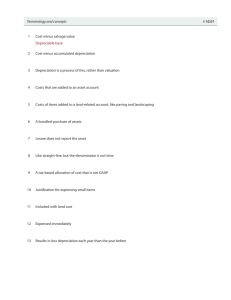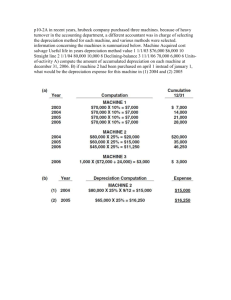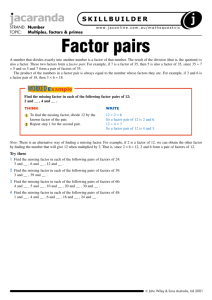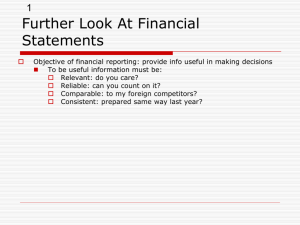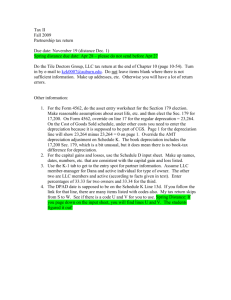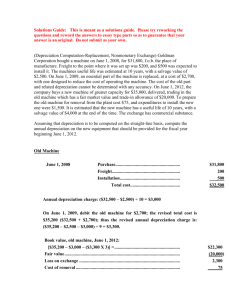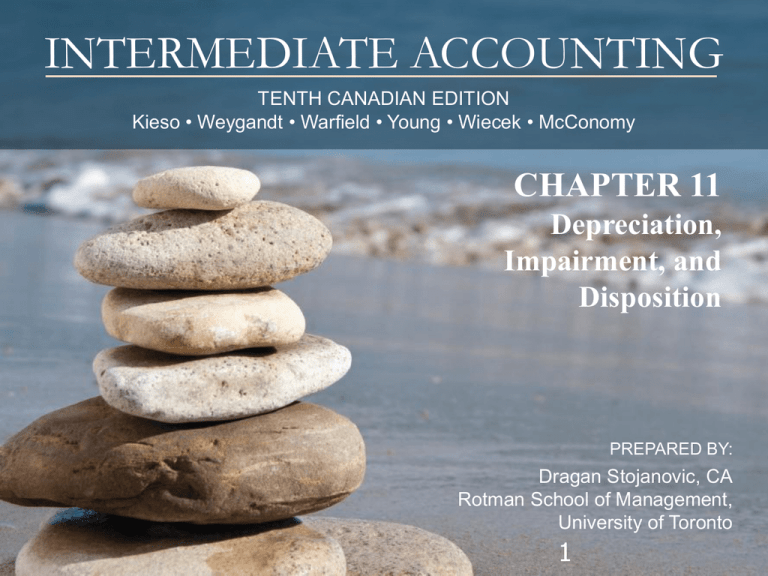
INTERMEDIATE ACCOUNTING
TENTH CANADIAN EDITION
Kieso • Weygandt • Warfield • Young • Wiecek • McConomy
CHAPTER 11
Depreciation,
Impairment, and
Disposition
PREPARED BY:
Dragan Stojanovic, CA
Rotman School of Management,
University of Toronto
1
CHAPTER 11:
Depreciation, Impairment, and Disposition
After Studying this chapter you should be able to:
• Understand the importance of depreciation, impairment, and disposition from a
• business perspective.
• Explain the concept of depreciation and identify the factors to consider when
determining
• depreciation charges.
• Identify how depreciation methods are selected.
• Calculate depreciation using the straight-line, decreasing charge, and activity
methods and
• recognize the effects of using each.
• Explain the accounting issues for depletion of mineral resources.
• Explain and apply the accounting procedures for partial periods and a change in
• depreciation rate.
Copyright John Wiley & Sons Canada,
Ltd.
2
CHAPTER 11:
Depreciation, Impairment, and Disposition
After studying this chapter you should be able to (continued):
• Explain the issues and apply the accounting standards for capital asset
impairment
• under both IFRS and ASPE.
• Explain and apply the accounting standards for long-lived assets that are held
for sale.
• Account for derecognition of property, plant, and equipment.
• Describe the types of disclosures required for property, plant, and equipment.
• Analyze a company’s investment in assets.
• Identify differences in accounting between ASPE and IFRS, and what changes
are expected
• in the near future.
• Calculate capital cost allowance in straightforward situations.
Copyright John Wiley & Sons Canada,
Ltd.
3
Depreciation, Impairment and
Disposition
Depreciation– A
Method of
Allocation
Impairment
•Factors considered
•Impairment –
recognition and
measurement
models
•Methods of
allocation
•Depreciation –
methods of
calculation
•Depletion of
mineral resources
Held for Sale and
Derecognition
•Indicators of
impairment
•Long-lived assets to
be disposed of by sale
•Derecognition
Presentation,
Disclosure, and
Analysis
•Presentation and
disclosure
IFRS/ASPE
Comparison
•Comparison of
IFRS and ASPE
•Looking ahead
•Analysis
•Asset groups and
cash-generating
units
•Other depreciation
issues
Copyright John Wiley & Sons Canada,
Ltd.
4
Depreciation – Concept
• Depreciation (and amortization more
broadly) is a means of cost allocation
• It is not a method of valuation
• Depreciation involves:
– allocating the depreciable amount of property,
plant, and equipment over the periods
expected to benefit from the use of the assets
• This allocation is generally recognized as
Depreciation Expense
Copyright John Wiley & Sons Canada,
Ltd.
5
Factors in the Depreciation Process
Questions to be answered to determine the
amount of depreciation expense:
1. What asset components are depreciated
separately?
2. What is the asset’s depreciable amount?
3. Over what period is the asset depreciated?
4. What pattern best reflects how the asset’s
economic benefits are used up?
Copyright John Wiley & Sons Canada,
Ltd.
6
Components Depreciated Separately
• Each significant part of a PP&E asset should be
identified and depreciated as a separate
component
• Multiple components may be grouped for
calculating depreciation if they have same useful
lives and depreciation methods
• Parts of each PP&E asset that are not individually
significant can be grouped and depreciated as a
single component
• Application of components for the purpose of
depreciation is required by both ASPE and IFRS.
However, IFRS is more detailed and strict.
Copyright John Wiley & Sons Canada,
Ltd.
7
Depreciable Amount
• Depreciable amount is initially calculated as:
•
•
•
•
•
Original cost of the asset
less estimated residual value (or salvage value)
IFRS does not permit the use of salvage value
Residual value is the net amount expected to be
received for the asset today if it were of the age and in
the condition expected at the end of its useful life
Salvage value is the asset’s estimated net realizable
value at the end of the asset’s life
Residual value should be reviewed regularly (at least
annually under IFRS)
Depreciation continues as long as residual value is lower
than asset’s carrying amount
Copyright John Wiley & Sons Canada,
Ltd.
8
Depreciation Period
• Depreciation begins when the asset is available for use
• Depreciation ends when the asset is derecognized or
classified as held for sale.
• An asset’s useful life and physical life are not the same
(expressed in time or units)
• Useful life is sometimes referred to as the economic
life—the period of time over which the asset will produce
revenue for the company
• Factors affecting useful life are:
•
•
•
economic factors (e.g. obsolescence)
physical factors (e.g. wear and tear)
legal life (e.g. expiration of contract)
Copyright John Wiley & Sons Canada,
Ltd.
9
Choice of Depreciation Method
• Depreciation method determines the systematic
allocation of the depreciable amount over the asset’s
useful life
• Depreciation should reflect the pattern of benefits
expected from the use of the asset
• Additional considerations for choosing a particular
depreciation method include simplicity, cost, as well as
perceived economic consequences
• Depreciation method affects:
– The balance sheet
– The income statement
– The ratios (e.g. return on assets, etc)
Copyright John Wiley & Sons Canada,
Ltd.
10
Depreciation Methods: Overview
Depreciation
Methods
Financial Accounting
Depreciation Methods
Straight-Line
Method
Diminishing
Balance
Method
Tax
Depreciation
Activity
Method
Copyright John Wiley & Sons Canada,
Ltd.
Special
methods
11
Comparison of Methods
Straight-Line Method
• Simple to use
• Based on two broad
assumptions:
– Constant usage
– Other costs same each
year
Diminishing Balance Method
• Best match of some assets’
productivity to cost
• More depreciation in earlier
years when asset has
greatest benefit
• Distorts rate of return
analysis
Activity Method
• Only appropriate where usage is not a function of time
• Difficult to estimate total number of units over life of asset
Copyright John Wiley & Sons Canada,
Ltd.
12
Depreciation Methods: Example
Crane Ltd. buys a crane at the beginning of the current
fiscal year. Information relating to the crane follows:
•
•
•
•
Cost: $500,000
Estimated useful life: five years (or 30,000 hours)
Residual value (end of five years of use): $50,000
Actual hours used during the current year: 4,000
hours and assume 4,700 in next year
Based on this information, calculate the amortization for the
current year using: straight-line, decreasing charge, and
activity methods
Copyright John Wiley & Sons Canada,
Ltd.
13
Straight-Line Method
1. Depreciable amount = $500,000 – $50,000 = $450,000
2. Annual Depreciation = $450,000 / 5 years = $90,000
3. Depreciation Schedule:
Book
Depreciation Accumulated Book value
Year Value
Expense
Depreciation End of year
1 $500,000 $90,000
$ 90,000
$410,000
2 $410,000 $90,000
$180,000
$320,000
Note that the depreciation
expense is the same
Copyright John Wiley & Sons Canada,
eachLtd.year
14
Diminishing Balance Method: DoubleAsset’s residual
Declining-Balance Method
value is not
1. Rate of Depreciation = 2 × (1/5) = 40%
deducted
Last year is rounded.
2. Depreciation (current)
= $500,000 × 0.40 = $ 200,000
Rate= (100%
Book value cannot be
Depreciation (next)
=
($500,000
$200,000)
× 0.40
Useful Life)
less than residual
= $120,000value.
x2
3. Depreciation Schedule:
Book Depreciation Accumulated
Year Value
Expense Depreciation
1 $500,000 $200,000
$200,000
2 $300,000 $120,000
$320,000
3 $180,000 $ 72,000
$392,000
4 $108,000 $ 43,200
$435,200
5 $ 64,800 $ 14,800
$450,000
Copyright John Wiley & Sons Canada,
Ltd.
Book value
End of year
$300,000
$180,000
$108,000
$ 64,800
$ 50,000
15
Activity Method (unit = hour)
1. Depreciable amount = $500,000 – $50,000 = $450,000
2. Depreciation per hour = $450,000 / 30,000 = $15.00
3. Depreciation (current) = $15.00 × 4,000 hours = $60,000
Depreciation (next) = $15.00 × 4,700
hours = $70,500
This same rate
is used each
year
4. Depreciation Schedule:
Book
Depreciation Accumulated Book value
Year
Value
Expense
Depreciation End of year
1 $500,000 $60,000
$ 60,000
$440,000
2 $440,000 $70,500
$130,500
$369,500
Copyright John Wiley & Sons Canada,
Ltd.
16
Depletion of Natural Resources
• Natural resources are depleted (amortized) over
•
•
•
•
time as they are removed
Depletion is calculated using an activity method
(such as units-of-production)
The depletion charge is initially debited to
Inventory
When the resource is sold, Inventory is credited
and Cost of Goods Sold is debited
Where an equipment’s useful life is clearly linked
to the life of the resource, it is also amortized
using the units-of-production method
Copyright John Wiley & Sons Canada,
Ltd.
17
Depletion: Example
Mining Company has right to use land to mine gold:
Lease cost:
$
50,000
Exploration cost:
$ 100,000
Development cost:
$ 850,000
Total capitalized cost:
$1,000,000
Estimated production (useful life*) = 100,000
ounces of gold
*Note: useful life is the # of units estimated to be in the
resource deposit
Copyright John Wiley & Sons Canada,
Ltd.
18
Depletion: Example
Depletion Rate = Total cost – residual value
Total estimated units
Depletion Rate = $1,000,000 – 0 = $10 per ounce
100,000
Entry to record 25,000 ounces mined:
Inventory
250,000
Accumulated depletion
250,000
Copyright John Wiley & Sons Canada,
Ltd.
19
Partial Year Depreciation
• When an asset is acquired sometime
during the year, a partial depreciation
charge is sometimes taken
• The procedure is:
•
•
determine depreciation for a full year, and
allocate the amount between the two periods
affected (see upcoming example)
Copyright John Wiley & Sons Canada,
Ltd.
20
Depreciation and Partial Periods
Straight-Line Method
• Calculate the amortization for the portion of
the year
• Generally use the nearest full month
Declining-Balance Method
• More complex calculations involved
Units of Production/Use Method
• No special calculations required
• Calculate the usage rate and apply to actual
usage for the period
• Same rate used in subsequent years
Copyright John Wiley & Sons Canada,
Ltd.
21
Partial Year Depreciation: Example
• Asset purchased on July 1, 2014. Information
relating to the asset is:
• Cost: $10,000
• Estimated service life: five years
• Residual value end of five years: none
• Determine depreciation expense under the doubledeclining-balance method
Determine full year depreciation as follows:
First full year = $10,000 x 40% = $4,000
Second full year = $6,000 x 40% = $2,400
Third full year = $3,600 x 40% = $1,440
Copyright John Wiley & Sons Canada,
Ltd.
22
Partial Year Depreciation: Example
Date of purchase, July 1, 2014
Allocate first full year’s
depreciation of $4,000
between 2014 and 2015
$2,000
2014
Allocate second full year’s
depreciation of $2,400
between 2015 and 2016
$2,000 $1,200
$1,200
2015
2016
Copyright John Wiley & Sons Canada,
Ltd.
23
Revision of Depreciation Estimates
• Determination of depreciation involves estimates
of useful life, residual value, pattern in which asset
benefits will be received
• These estimates need to be reviewed regularly
(under IFRS, at least at the end of every fiscal
year end)
• When these estimates are revised, depreciation is
recalculated
• The revised depreciation is applied prospectively
to the remaining life of the asset, i.e., it is
accounted for in the period of the change and to
future periods
• The changes do not affect prior periods
Copyright John Wiley & Sons Canada,
Ltd.
24
Revision of Depreciation Estimates:
Example
• Depreciable asset purchased for $90,000
– Estimated life was 20 years
– Estimated residual value was $10,000
– Pattern of benefits received: equal amounts
per period
• In year 9, estimates were revised as follows:
– Estimated life: total of 30 years
– Estimated residual value: $2,000
• Determine amortization for 9th year based on the
straight-line method of depreciation
Copyright John Wiley & Sons Canada,
Ltd.
25
Revision of Depreciation Estimates:
Example
• Book value of the asset at the date of revision of
estimates:
•
•
•
($90,000 – $10,000) / 20 years = $4,000 per year
$4,000 × 8 years = $32,000 of Accumulated
Depreciation
Book value: $90,000 – $32,000 = $58,000
• Amount to be depreciated (9th to 30th year = 22 years
remaining)
•
($58,000 – $2,000) / 22 years = $2,545 each year
Copyright John Wiley & Sons Canada,
Ltd.
26
Impairment: Overview
• Impairment occurs when the carrying amount of the
•
•
•
•
long-lived asset (such as PP&E) is greater than its future
economic benefit to the company
There are many external and internal indicators that
provide evidence of possible impairment
Management needs to regularly evaluate assets for
these indicators of impairment
– IFRS requires this at the end of each reporting period
If there is an indicator of possible impairment, then the
asset must be tested for impairment
Two main approaches to measuring impairment losses
are:
– Cost recovery impairment model
– Rational entity impairment model
Copyright John Wiley & Sons Canada,
Ltd.
27
Cost Recovery Impairment Model
• Under this model, an asset is impaired only if carrying
amount cannot be recovered from using and eventually
disposing of the asset (recoverability test)
– i.e. impaired if carrying amount > undiscounted future net
cash flows
• Impairment loss is then measured as asset’s
– carrying amount
– less fair value
• Fair value of the asset is best measured by quoted
market prices in active markets
– It is by its nature a present value or discounted measure
• Impairment losses cannot be reversed
• Applied by ASPE
Copyright John Wiley & Sons Canada,
Ltd.
28
Rational Entity Impairment Model
• Impairment loss is measured by comparing the asset’s
carrying amount and recoverable amount
• Recoverable amount is measured as higher of
1.
Value in use, and
(present value of future net cash flows)
2.
Fair value less cost to sell
• If carrying amount < recoverable amount, then there is
no impairment loss
• If carrying amount > recoverable amount, then
impairment loss is difference between two values
• Impairment losses may be reversed
• Applied under IFRS
Copyright John Wiley & Sons Canada,
Ltd.
29
Asset Groups and Cash-Generating
Units (CGU)
•
•
•
•
•
Many assets do not generate cash flows independently, so
impairment analysis cannot be done at the level of the individual
asset
These assets are identified with an asset group or cash-generating
unit (CGU)
– i.e. “smallest identifiable group of assets that generates cash
inflows that are largely independent of the cash flows from other
assets or groups of assets” (IAS 36.6)
Both cost recovery and the rational entity impairment models are
then applied to the groups of assets, instead of the individual asset
Any impairment losses are then allocated to individual assets on a
pro-rata basis
No individual asset should be reduced below its fair value (under
cost recovery model) or recoverable amount (under rational entity
model) – if these amounts are known
Copyright John Wiley & Sons Canada,
Ltd.
30
Held for Sale
• Long-lived asset is classified as held for sale if the
company intends on disposing the asset by sale
and meets strict criteria (described in Ch. 4)
• Held for sale assets are
– Reported separately on the balance sheet
– Not depreciated
– Measured at the lower of
• Carrying amount, and
• Fair value less costs to sell
• Subsequent increases in net realizable value may
be recognized as gains, but only to the extent they
offset previously recognized losses
Copyright John Wiley & Sons Canada,
Ltd.
31
Derecognition
• Plant assets may be:
– retired voluntarily, or disposed of by sale,
exchange, involuntary conversion, donation
• Depreciation is recorded up to the date of disposal
before determining gain or loss
• Gains or losses from disposal are normally shown
with “Other” revenues and expenses in the income
statement
Copyright John Wiley & Sons Canada,
Ltd.
32
Presentation and Disclosure
•
•
•
There are many significant disclosures
required for property, plant, and equipment
Types of disclosures include the following:
–
–
–
–
–
cost and the accumulated depreciation
depreciation method and rate or period
assumptions surrounding fair-value-related
measurements
carry amounts of assets held for sale
outstanding contingencies
Specific standards under IFRS generally
have more extensive disclosure
requirements compared to ASPE
Copyright John Wiley & Sons Canada,
Ltd.
33
Analysis of Property, Plant, and
Equipment
1. Activity analysis
(efficiency in using assets to generate revenues)
Total Asset Turnover =
Net Revenue
Average Total Assets
2. Profitability analysis
(net income earned from each sales dollar):
Profit Margin =
Net Income
Net Revenue
Copyright John Wiley & Sons Canada,
Ltd.
34
Analysis of Property, Plant, and
Equipment
Return on Assets
(effect long-lived assets have on profitability):
= Asset Turnover ×
Profit Margin
×
= Net Revenue
Average Total Assets
Net Income
Net Revenue
= Net Income
Average Total Assets
Copyright John Wiley & Sons Canada,
Ltd.
35
IFRS and ASPE
• ASPE and IFRS are consistent in many
areas of accounting for depreciation and
disposition
• Most significant difference between the
two standards relates to measurement of
impairment losses
• There are no major changes expected in
this area
Copyright John Wiley & Sons Canada,
Ltd.
36
COPYRIGHT
Copyright © 2013 John Wiley & Sons Canada, Ltd. All
rights reserved. Reproduction or translation of this
work beyond that permitted by Access Copyright (The
Canadian Copyright Licensing Agency) is unlawful.
Requests for further information should be addressed
to the Permissions Department, John Wiley & Sons
Canada, Ltd. The purchaser may make back-up copies
for his or her own use only and not for distribution or
resale. The author and the publisher assume no
responsibility for errors, omissions, or damages caused
by the use of these programs or from the use of the
information contained herein.

